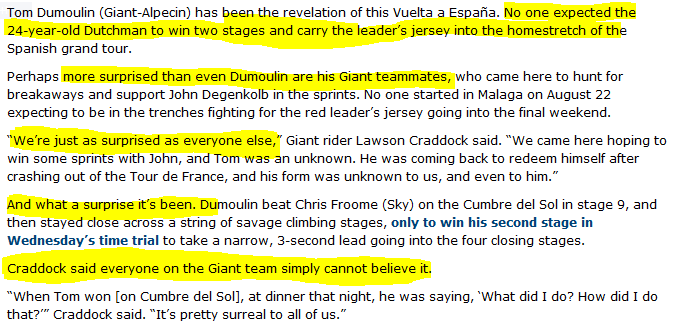- Sep 29, 2012
- 12,197
- 0
- 0
As always, I start with myself and think -- am I surprised at what I am doing. For me, it would rarely be that. I have training data showing me power values at different durations. Yes, it can improve in a race when doing a crit or in a break away but for the most part, my power / times in training matched my power in races, or everyone did better with ideal conditions in a TT or what have you.
The guys I train with can tell when I am coming into form also. They make comments like "You should go well this weekend", either based on training or recent racing form. The people around me are amateurs and they know how I am going.
I then project this collective understanding of my form and ability onto what a pro is saying. I am sure many will argue that I as an amateur am better prepared than a pro, but personally I do not accept that. And never will.
The detail of data available to me is also available to the pro, except they have more time to look at it, it costs them significantly less to capture it and they have people around them dedicated to their profession to analyse it. Their whole life is dedicated to being a better athlete.
And they don't know where they're at?
Seriously?
Then I think back to Tyler Hamilton, not feeling any better than usual after a transfusion. How he had to really dig to get the best from the new blood coursing through his veins. How surprised (all of a sudden) he was to find he could dig deeper, go harder for longer. (The Secret Race, page 91)

Even dopers can have bad days...

The guys I train with can tell when I am coming into form also. They make comments like "You should go well this weekend", either based on training or recent racing form. The people around me are amateurs and they know how I am going.
I then project this collective understanding of my form and ability onto what a pro is saying. I am sure many will argue that I as an amateur am better prepared than a pro, but personally I do not accept that. And never will.
The detail of data available to me is also available to the pro, except they have more time to look at it, it costs them significantly less to capture it and they have people around them dedicated to their profession to analyse it. Their whole life is dedicated to being a better athlete.
And they don't know where they're at?
Seriously?
Then I think back to Tyler Hamilton, not feeling any better than usual after a transfusion. How he had to really dig to get the best from the new blood coursing through his veins. How surprised (all of a sudden) he was to find he could dig deeper, go harder for longer. (The Secret Race, page 91)

Even dopers can have bad days...












